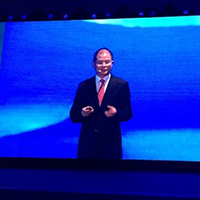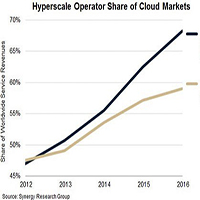In This Issue
- Airbnb Compute Model
- Livin’ on the Edge
- Fog Computing: Opps
- Report from the CEO
- High Goals for Cloud
- Huawei Cloud Spin-Off
- Hyperscale Cloud Ops
- Content Collaboration
- Optical Networking
- The Value of Hybrid
- Data Out of Control
- $3.5M Cybersecurity
- Education and ID Theft
- DARPA Fortified Chips
- Educate Employees
- C-Level Leaders
- Coming DCIA Events
The Airbnb Model Comes to Computing
 A new “distributed computing” model – think Airbnb for unused computer space – is aiming to let you make a little extra cash on the side by renting out empty hard drives.
A new “distributed computing” model – think Airbnb for unused computer space – is aiming to let you make a little extra cash on the side by renting out empty hard drives.
Despite ongoing concerns about safety (remember when we were nervous about getting into strangers’ cars?) and the fairly small amounts of money changing hands, those on the forefront of the movement are hoping to exploit even this small-scale idle resource, and maybe make a little extra on the side.
Every month, a couple of extra cryptocurrency coins go into Kevin Baird’s digital wallet.
He doesn’t cash them out into dollars very often, but when he does, he usually buys a new piece of tech – after all, he’s a computer programmer by day and tech-head in his spare time.
He earns the money by renting his spare computer space to a network of strangers: He has a couple of Raspberry Pi drives connected to his home Wi-Fi along with his personal computer, all of which is enough to generate a “few extra dollars,” he says, without having to lift a finger.
Five million computers are linked up to the University of California, Berkeley’s SETI@home project… Read More
Livin’ on the Edge: What’s After Cloud
Excerpted from Associations Now Report by Ernie Smith
 It’s too early to say whether or not associations should take edge computing, the successor to cloud computing, seriously.
It’s too early to say whether or not associations should take edge computing, the successor to cloud computing, seriously.
But what should be taken seriously is its potential.
Any good association IT department should research potential disruptors ahead of time.
Cloud computing isn’t dead yet. Far from it.
But it is becoming more mature. As Gartner recently pointed out, the technology is now in its second decade, at a point where if you’re not using it for mainstream enterprise applications yet, you should really get on that.
But maturity implies a point of limitation-that things have reached their peak.
And that’s leading some to wonder what’s next. Even as the cloud defines the modern technology stack-and further, the way we interact with our vendors-there’s always a good chance that it may not stick with us forever.
That sounds more than a bit premature, but some of the technology world’s most prominent thinkers are already making this case… Read More
Fog Computing: Biz Opps & Disruptions
Excerpted from TechTarget Report by Tao Zhang
 Since the early 2000s, cloud computing has played a dominant role in enabling the many applications we rely on in our daily lives and business operations.
Since the early 2000s, cloud computing has played a dominant role in enabling the many applications we rely on in our daily lives and business operations.
However, as the internet of things (IoT) continues to gain traction, cloud computing alone becomes increasingly inadequate.
Many emerging applications require services a bit closer the edge, and can’t wait for data to travel all the way to the cloud and back.
The discussion has evolved from simply determining how fog computing will fill the technology gaps.
We know fog computing has to play a role in an IoT world, and so we need to start talking about the profound business opportunities and disruptions fog computing will bring.
The IoT world may be exciting, but there are serious technical challenges that need to be addressed, especially by developers.
Fog computing is already influencing how edge networks are being built… Read More
Report from DCIA CEO Marty Lafferty
 The DCIA proudly sponsors the eleventh annual Creative Storage Conference (CS 2017) taking place on May 24th at the Doubletree Hotel in Culver City, CA.
The DCIA proudly sponsors the eleventh annual Creative Storage Conference (CS 2017) taking place on May 24th at the Doubletree Hotel in Culver City, CA.
The full-day conference and tradeshow with exhibits will focus on all aspects of digital storage for professional media and entertainment, bringing together vendors, end-users, researchers, and visionaries.
Sessions will cover the impacts of 4K, HFR, and VR on content production workflow, cloud-based collaboration, transmission, archiving, and digital preservation.
Keynotes will include Lucas Wilson, Founder and Executive Producer, SuperShereVR; Dave Fredrick, Senior Director of Media and Entertainment; Michelle Munson, Co-Founder and CEO, Aspera; and a to-be-announced speaker from Google Media Cloud.
CS 2017 will enable attendees to learn a great deal about the latest digital storage, content delivery, and data management solutions for the media and entertainment industries.
Delegates will meet and network with influential and knowledgeable media professionals who are using digital storage to advance their art.
Don’t miss out on this attractively priced opportunity to find the best digital storage tools to advance your business.
The theme of CS 2017 is The Next Act of Storage: Digital Storage Makes Art Happen.
Several levels of conference, website, and event sponsorship are still available as well as a table-top exhibits. Information on the sponsorship and exhibit opportunities is available here.
You can register for CS 2017 here with a $150 discount off the regular full conference registration.
Share wisely, and take care.
High Goal Set in Cloud Computing
Excerpted from ShanhaiDaily Report by Yang Wong
 China is aiming to increase the scale of its cloud computing industry by more than 2.5 times by 2019, from 2015 levels, according to a new government plan.
China is aiming to increase the scale of its cloud computing industry by more than 2.5 times by 2019, from 2015 levels, according to a new government plan.
The scale of the cloud computing industry will be expanded to 430 billion yuan (US $62.4 billion) by 2019, up from 150 billion yuan in 2015, according to an action plan for 2017-2019 issued by the Ministry of Industry and Information Technology.
Other targets include making breakthroughs in core technologies, increasing cloud computing in manufacturing and government affairs, and strengthening the global influence of Chinese cloud computing companies.
The ministry expects that two to three Chinese cloud computing companies will lead the global market within three years.
Cloud computing should be a strong support for China’s manufacturing and Internet industries and help make other social and economic sectors more information-based, the ministry said.
It pledged to enhance cloud computing network security and improve security regulation and relevant laws, as many users from key industries are still hesitating due to safety concerns, reliability and movability… Read More
Huawei to Spin-Off Cloud Business
Excerpted from Mobile World Live Report by Joseph Waring
 Huawei stepped up its already strong commitment to the cloud by announcing plans to create a separate cloud business unit.
Huawei stepped up its already strong commitment to the cloud by announcing plans to create a separate cloud business unit.
The new unit will be the company’s fourth business group after carrier, consumer (devices) and enterprise.
The company said a year ago it would invest $1 billion to expand its cloud business.
Eric Xu, Huawei’s rotating CEO (pictured), said it has been pushing its new public cloud platform both independently and by partnering with operators in some countries, such as Deutsche Telekom in Germany.
He argued Huawei needs to first become a digital company itself in order to lead telcos down the path towards digitalization: “We face the exact same issues that operators face. The key is to take action, not to have a discussion.”
Xu said Huawei sees artificial intelligence (AI) as an enabling technology to increase the value of its existing products, not as an independent industry, and Huawei won’t develop an AI business.
“AI will be everywhere in our products, solutions and operations in the future.
We’ll use AI to automate and drive improvements in efficiency… Read More
Market Favors Hyperscale Cloud Operators
Excerpted from Datamation Report by Pedro Hernandez
 Businesses are increasingly migrating their IT workloads to the cloud, benefiting hyperscale cloud operators the most, finds a new study from Synergy Research Group.
Businesses are increasingly migrating their IT workloads to the cloud, benefiting hyperscale cloud operators the most, finds a new study from Synergy Research Group.
Currently, there are 24 cloud operators that fit the bill, according to the technology analyst firm.
In general, a hyperscale cloud providers have a broad data center footprint, each with 45 or more data centers across the globe.
They operate at least two data centers in each major region, namely North America, Latin America, Europe, Middle East and Africa (EMEA) and Asia-Pacific (APAC).
Typically, they have hundreds of thousands of servers at their disposal, or in the case of cloud giants Amazon and Google, millions of servers.
Combined, these 24 hyperscale cloud companies, a group that also includes Microsoft and IBM, operate nearly 320 data centers worldwide… Read More
Today’s Content Calls for Cloud Collaboration
Excerpted from Videoedge Report by Andy Hurt
 Watching a program at a specific time on the household TV is no longer the only way to consume media.
Watching a program at a specific time on the household TV is no longer the only way to consume media.
Over-the-air TV broadcasts have given way to on-demand content of every conceivable sort from an ever-growing number of sources.
Consumers have come to demand all kinds of content on any device in any location.
This drastic change in viewing habits is driving an equally drastic change in how content is created.
Entities like Netflix and Amazon, whose productions rival those of the biggest networks and movie studios, have rendered the historical model less relevant every day.
Even viewers are getting in on the action and generating content themselves. (Think everyone from football fans who post their favorite highlights, to YouTube stars who garner hundreds of thousands of followers.)
The same holds true for content distribution.
Until recently, most content was created for linear programming and handed off to a cable or satellite company for distribution… Read More
Cloud Boom Rains Money on Optical Networking
Excerpted from MarketWatch Report by Therese Poletti

Applied Optoelectronics proved Wednesday that the boom in optical-networking products is not slowing down as companies build out corporate and cloud-computing data centers.
On Tuesday, Applied Optoelectronics said its first-quarter results will easily exceed its previous guidance, thanks to the “continued robust demand” for its data center products.
The company did not say much beyond its raised guidance and noted it will report final quarterly results on May 4, but the news fueled a 20% jump in its stock in after-hours trading.
In an investor presentation last month, Applied Optoelectronics executives talked about some of the reasons that were fueling strong demand for its products, comments that gave a window on the current market for fiber-optic components in general.
Chief Financial Officer Stefan Murry discussed a major paradigm shift in the data center from copper to optical components, as more companies adopt an open architecture and realize the likely need to expand.
He also noted that the transition of data to the cloud is still in its early days, which could mean more data centers will be built… Read More
The Value of Hybrid
Excerpted from CloudTech Report by Olly Pesland
 The term “hybrid cloud” has grown in popularity among established technology vendors, but one could be forgiven for thinking it’s a convenient “cloudwash” for companies to showcase progress while delaying an inevitable shift to public cloud.
The term “hybrid cloud” has grown in popularity among established technology vendors, but one could be forgiven for thinking it’s a convenient “cloudwash” for companies to showcase progress while delaying an inevitable shift to public cloud.
I say that because to focus exclusively on cloud overlooks the reality that almost every CIO in an established enterprise today is contending with legacy as much as the need to embrace new technologies.
Some critical data center hosted systems just don’t move to cloud so easily.
It’s all simply IT, which is why I call the effective combination of public cloud, managed service provider cloud, and dedicated infrastructure “hybrid IT.”
It is by no means intended as a “catch-all”, so I feel I owe it to the reader to explain precisely what I mean and how established companies are successfully exploiting the benefits of such choice on their terms.
At its core, hybrid is about choice: Choice to work with the appropriate combination of an organization’s on-premises infrastructure, managed services, private cloud and public cloud infrastructure and services… Read More
Don’t Let Your Data Get Out of Control
Excerpted from CloudTech Report by Melodye Mueller
 Cloud usage is accelerating at a rapid rate, and it’s showing no signs of slowing down.
Cloud usage is accelerating at a rapid rate, and it’s showing no signs of slowing down.
Right now, 90 percent of all companies are using the cloud in some way, and, in the next 10 years, spending on public cloud alone is slated to multiply by a factor of five to $500 billion, according to recent studies by North Bridge and Wikibon.
Enterprises are launching new infrastructure at a furious pace, migrating workloads of all kinds and big chunks of data to public and private cloud environments.
Many of these enterprises are generating tangible results – cutting out costs, increasing agility and getting products to market faster.
But cloud initiatives don’t come without growing pains.
If they aren’t managed closely, cloud projects can spiral out of control quickly, leaving a trail of data breaches, regulatory fines and cost overruns.
What organizations need is a strong governance program to ensure that their move to the cloud starts smoothly and continues to perform… Read More
Nevada Eyes $3.5 Million Cybersecurity Boost
Excerpted from Las Vegas Sun Report
 Governor Brian Sandoval is asking the Nevada Legislature to spend $3.5 million over the next two years to build up the state’s cybersecurity infrastructure and management.
Governor Brian Sandoval is asking the Nevada Legislature to spend $3.5 million over the next two years to build up the state’s cybersecurity infrastructure and management.
His proposed Office of Cyber Defense Coordination would organize data systems across all state agencies, partner with education officials on workforce development and consult private businesses on best practices.
Existing cybersecurity protocols are designed to protect the sensitive information of Nevada residents and anyone who does business here.
An attorney for the governor’s office says financial and personal securities rely only in part on the machines and software that house that information.
Defense adviser Brigadier General Bill Burks says frequent collaboration and human oversight are also crucial to mitigate and respond to attacks.
No one spoke against Assembly Bill 471 at its first legislative hearing Friday… Read More
Education Greater Risk for Identity Theft
Excerpted from IT Business Edge Report by Sue Poremba
 I’m all about being educated and understanding the risks involved every time you connect to the internet or access your company’s network or handle sensitive data.
I’m all about being educated and understanding the risks involved every time you connect to the internet or access your company’s network or handle sensitive data.
But can being educated actually work against cybersecurity efforts?
A study conducted by online IT training company CBT Nuggets found that overconfidence in our abilities, and in our devices, can end up resulting in identity theft
According to the survey of more than 2,000 respondents, 18 percent of those who admit to being tech savvy are more likely to become victims of identity theft.
Also, more education increases your risk, with 24 percent of PhDs stating that they have been a victim of identity theft at some time, as opposed to 11 percent of high school graduates and 14 percent of those with a bachelor’s degree.
Now, there could be a number of reasons for the disparity in the numbers, such as the amount of time someone with only a high school degree spends on a computer versus that of someone with an advanced degree… Read More
DARPA Baking Chips with Cybersecurity Fortification
Excerpted from Network World Report by Michael Cooney
 In an IT world where security software patches seem to be a dime a dozen, the researchers at the Defense Advanced Research Projects Agency (DARPA) want to take a different approach – bake cybersecurity right into the circuitry.
In an IT world where security software patches seem to be a dime a dozen, the researchers at the Defense Advanced Research Projects Agency (DARPA) want to take a different approach – bake cybersecurity right into the circuitry.
The research outfit will this month detail a new program called System Security Integrated Through Hardware and Firmware (SSITH) that has as one of its major goals to develop new integrated circuit architectures that lack the current software-accessible points of criminal entry, yet retain the computational functions and high-performance the integrated circuits were designed to deliver.
Another goal of the program is the development of design tools that would become widely available so that hardware-anchored security would eventually become a standard feature of integrated circuit in both Defense Department and commercial electronic systems, DARPA stated.
“Security for electronic systems has been left up to software until now, but the overall confidence in this approach is summed up in the sardonic description of this standard practice as ‘patch and pray,'” said SSITH program manager Linton Salmon of the Agency’s Microsystems Technology Office… Read More
Educate Employees on Cloud Security
Excerpted from CloudTech Report by James Bourne
 For those at the coalface of the security industry, the feeling of metaphorically banging one’s head against a brick wall, of continually educating, re-educating and correcting misinformation, mischievous or otherwise, will feel all too familiar.
For those at the coalface of the security industry, the feeling of metaphorically banging one’s head against a brick wall, of continually educating, re-educating and correcting misinformation, mischievous or otherwise, will feel all too familiar.
Take the comments from Home Secretary Amber Rudd around WhatsApp following the terror attack in Westminster.
Following the disclosure that the messaging service was used moments before the attacker struck, Rudd’s remarks – “there should be no place for terrorists to hide” – were met with a certain level of dismay in the industry.
Graham Cluley, a long-standing independent security analyst, put it this way.
“There is a danger that politicians will take ghastly incidents of terror as a platform to push forward their agenda of weakening encryption,” he wrote.
“It makes them sound tough in the fight against terror – at least to people who don’t know much about technology. But it won’t make a blind jot of difference to bad guys.”
With other technologies, such as cloud and Wi-Fi, a similar effect occurs… Read More
C-Level Leaders and Cybersecurity
Excerpted from Computerworld Report by Matt Hamblen
 Despite the scale and potential harm from cyber-attacks, there’s wide recognition that corporate leaders, especially boards of directors, aren’t taking the necessary actions to defend their companies against such attacks.
Despite the scale and potential harm from cyber-attacks, there’s wide recognition that corporate leaders, especially boards of directors, aren’t taking the necessary actions to defend their companies against such attacks.
It’s not just a problem of finding the right cyber-defense tools and services, but also one of management awareness and security acumen at the highest level, namely corporate boards.
“Our country and its businesses and government agencies of all sizes are under attack from a variety of aggressive adversaries and we are generally unprepared to manage and fend off these threats,” said Gartner analyst Avivah Litan, a longtime cybersecurity consultant to many organizations.
Litan’s worries seem to have reached some quarters of the corporate governance community.
The National Association of Corporate Directors (NACD) recently released a survey of more than 600 corporate board directors and professionals that found only 19% believe their boards have a high level of understanding of cybersecurity risks. That’s an improvement from 11% in a similar poll conducted a year earlier.
Meanwhile, when an attack does happen, there seems to be an excess of finger-pointing in the C-suite… Read More
Coming Events of Interest
Delivery of Things World — April 24th and 25th in Berlin, Germany. Over 400 IT executives will discuss what DevOps really means for business. This event brings together all stakeholders to share their experience and expertise.
Security of Things World — June 12th and 13th in Berlin, Germany. A world class event focused on the next information security revolution. Security concerns that preoccupy enterprise customers today and pragmatic solutions to threats.
Autonomous Systems World — June 14th and 15th in Berlin, Germany. An international knowledge exchange among top experts in the field, providing a unique glimpse into the fascinating world of autonomous robots, intelligent machines, and smart technologies.
INTRASECT — June 29th and 30th in Washington, DC. The first conference of its kind to engage key stakeholders in a comprehensive and engaging examination of existing and future regulatory policy governing the usage of commercial autonomous vehicles.
Industry of Things World Asia — July 3rd and 4th in Singapore. An international knowledge exchange platform bringing together more than 300 high-level executives who play an active role in the industrial internet of things (IoT).
Industry of Things World Europe — September 18th and 19th in Berlin, Germany. Join more than 1,000 high-level executives to rethink your technology and business strategy for scalable, secure, and efficient IoT.
